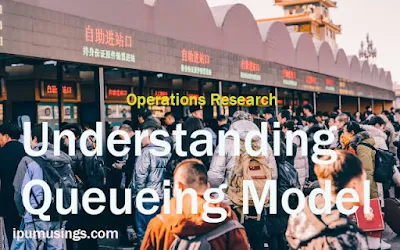Operations Research - Understanding Queueing Model #mbanotes #operationsresearch #queueuingmodel
Operations Research - Understanding Queueing Model
A queueing problem is defined as a stream of customers coming at one or more service facilities at random. Customers may be served immediately or may have to wait till the facility is available if they are willing to wait.
Arrivals are distinguished either by the number of arrivals in a given period of time or by the interval between two successive arrivals, known as interarrival time. Interarrival periods are continuous random variables, whereas the number of arrivals is a discrete random variable.
The number of services done in a specific time period or the time it takes to finish the service defines the service. The quantity of completed services is a discrete random variable, whereas the time it takes to complete them is a continuous random variable.
Other features of a queueing model include the number of servers, the sequence in which they are served, the size of the customer population, and the queue's maximum length. Kendall's notation is a convenient shorthand for expressing the many aspects of a queueing problem.
The time spent by an arriving consumer in a queueing system is a random variable that is of relevance to the decision-maker. If the customer in question is a down machine, it will be unusable during the service period. As a result of its inability to perform, there is a cost. One of the goals of researching a queueing problem is to determine the best service rate and a number of servers such that the average cost of being in the queue and the cost of service are as low as possible. Waiting time is a random variable that refers to the amount of time a customer spends in a system prior to receiving service. The probability distribution of waiting time is determined by the inter-arrival time and service time probability distributions.
The probability of having n consumers in the system at time t is denoted by Pn(t). The queueing system is considered to be in the transitory state if P,,(t) is dependent on t. After the queuing system has been operational for a long time, the probability Pn(t) may become independent of t. The probabilities are referred to as steady-state probabilities at this point.
The arrivals are said to follow a Poisson Process when the number of arrivals in a time interval of length t follows a Poisson distribution with mean Jet, where A is the rate of arrival. Interarrival times are randomly distributed random variables having an exponential probability distribution with parameter X in this example, and vice versa. The resulting queueing model is denoted as M/M/I in Kendall's notation if the service times are independently, identically distributed exponential random variables with parameter 11 and there is only one server in the queueing model. If an exponential distribution with parameter μ-h is used to model a system that includes both waiting and service time.
The probability distribution of arrivals and service in an M/MIC system is identical to that of an M/M/I system, except there are C servers providing service at the same time. The odds of a steady-state exist if 1/Cμ < 1. In a M/EW/I system, the number of arrivals follows a Poisson process, while the service times are exponentially distributed with a common parameter in k separate phases. For k =, we have a queueing model with a Poisson process for the number of arrivals and a constant service time.
A queueing model's optimum service rate can be computed using a calculus method that minimises the sum of service and waiting costs per unit time.




